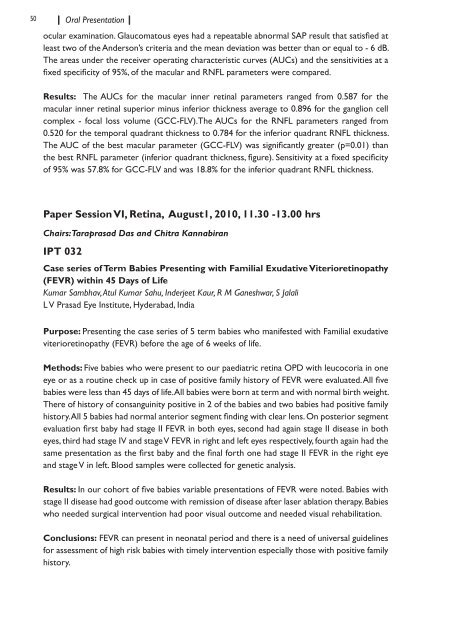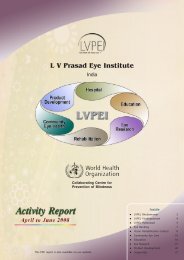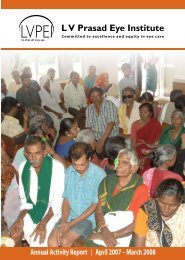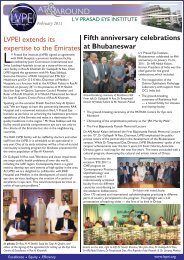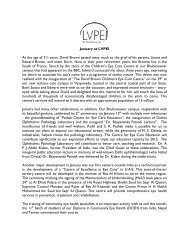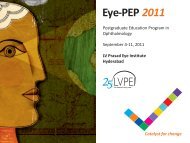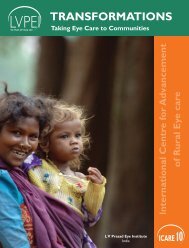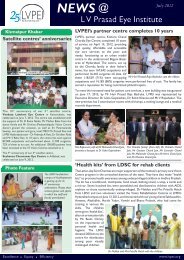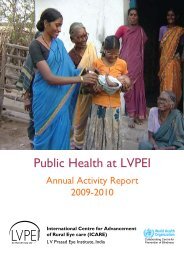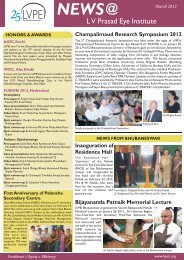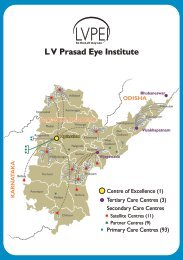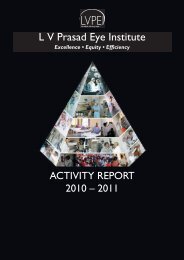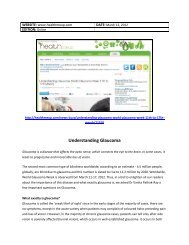IERG Abstracrt Book.indd - LV Prasad Eye Institute
IERG Abstracrt Book.indd - LV Prasad Eye Institute
IERG Abstracrt Book.indd - LV Prasad Eye Institute
You also want an ePaper? Increase the reach of your titles
YUMPU automatically turns print PDFs into web optimized ePapers that Google loves.
50 Oral Presentationocular examination. Glaucomatous eyes had a repeatable abnormal SAP result that satisfied atleast two of the Anderson’s criteria and the mean deviation was better than or equal to - 6 dB.The areas under the receiver operating characteristic curves (AUCs) and the sensitivities at afixed specificity of 95%, of the macular and RNFL parameters were compared.Results: The AUCs for the macular inner retinal parameters ranged from 0.587 for themacular inner retinal superior minus inferior thickness average to 0.896 for the ganglion cellcomplex - focal loss volume (GCC-F<strong>LV</strong>).The AUCs for the RNFL parameters ranged from0.520 for the temporal quadrant thickness to 0.784 for the inferior quadrant RNFL thickness.The AUC of the best macular parameter (GCC-F<strong>LV</strong>) was significantly greater (p=0.01) thanthe best RNFL parameter (inferior quadrant thickness, figure). Sensitivity at a fixed specificityof 95% was 57.8% for GCC-F<strong>LV</strong> and was 18.8% for the inferior quadrant RNFL thickness.Paper Session VI, Retina, August1, 2010, 11.30 -13.00 hrsChairs: Taraprasad Das and Chitra KannabiranIPT 032Case series of Term Babies Presenting with Familial Exudative Viterioretinopathy(FEVR) within 45 Days of LifeKumar Sambhav, Atul Kumar Sahu, Inderjeet Kaur, R M Ganeshwar, S JalaliL V <strong>Prasad</strong> <strong>Eye</strong> <strong>Institute</strong>, Hyderabad, IndiaPurpose: Presenting the case series of 5 term babies who manifested with Familial exudativeviterioretinopathy (FEVR) before the age of 6 weeks of life.Methods: Five babies who were present to our paediatric retina OPD with leucocoria in oneeye or as a routine check up in case of positive family history of FEVR were evaluated. All fivebabies were less than 45 days of life. All babies were born at term and with normal birth weight.There of history of consanguinity positive in 2 of the babies and two babies had positive familyhistory. All 5 babies had normal anterior segment finding with clear lens. On posterior segmentevaluation first baby had stage II FEVR in both eyes, second had again stage II disease in botheyes, third had stage IV and stage V FEVR in right and left eyes respectively, fourth again had thesame presentation as the first baby and the final forth one had stage II FEVR in the right eyeand stage V in left. Blood samples were collected for genetic analysis.Results: In our cohort of five babies variable presentations of FEVR were noted. Babies withstage II disease had good outcome with remission of disease after laser ablation therapy. Babieswho needed surgical intervention had poor visual outcome and needed visual rehabilitation.Conclusions: FEVR can present in neonatal period and there is a need of universal guidelinesfor assessment of high risk babies with timely intervention especially those with positive familyhistory.


